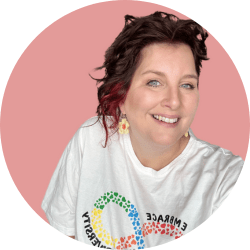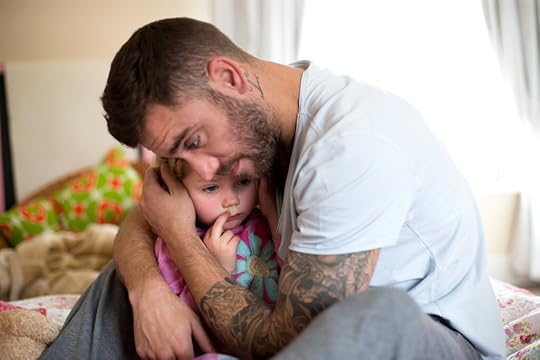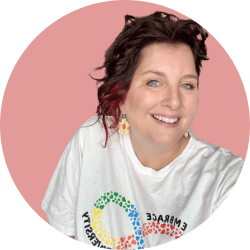Tanya Valentin's Blog, page 5
September 1, 2024
The Nine Sensory Systems With OT Elen Nathan From The Playful Place – Part One
Today I am joined by occupational therapist and sensory integration practitioner, Elen Nathan.
In this episode:
Elen gives us an introduction to the nine sensory systems and why these are important for us as parents to be aware of.Elen and I chat about practical examples of what this could look like for our children, how we can be more aware of our child’s sensory world and how this can contribute to their sense of safety.We chat about the importance of tuning into and trusting our intuition as parents when it comes to knowing what is right for our children.We talk about how we can change our parenting approach and provide accommodations to meet our children where they are to better support them.To get your free sensory system screening tools:
https://sensationalbrain.com/free-resources
You can connect with Elen Nathan here:
Website: https://theplayfulplace.co.nz/
Facebook: https://www.facebook.com/ThePlayfulPlace
Click here to find out more about the Neurodivergent Family Toolbox
If you would like to join the conversation by being a guest on the show, please email Tanya at tanya@tanyavalentin.com.
Join our FREE Parenting Community
The post The Nine Sensory Systems With OT Elen Nathan From The Playful Place – Part One appeared first on Tanya Valentin.
June 3, 2024
Why They’re Not ‘Fine’ – Exploring Autistic Masking Through a Polyvagal Lens
You are waiting in your car for your child at the end of the school day. You see them coming down the pathway towards the school gate.
Your child is chatting with a friend, everything seems fine.
As they approach the car you can see their body language and facial expression shift.
They open the car door and get in next to you.
“How was your day?” you ask in a cheery tone, and just like that, your seemingly happy child explodes.
What just happened? They were fine a minute ago!
Firstly, if this scenario feels familiar to you, I want to reassure you, this is not just you. This is an all too common scenario that happens in many neurodivergent families.
Your child is seemingly ‘fine’ at school, with a friend, in a social situation or at a grandparent’s house, but when they are around you or at home, you experience a completely different kid.
What’s going on?
Masking and Autistic KidsIt is widely accepted that this ‘Jekyll and Hyde’ type of behaviour is due to your autistic child’s masking or camouflaging their sensory needs and autistic traits in social situations. However, just because your child suppresses their needs or traits this doesn’t mean that they go away.
Under the surface, your child is experiencing extreme sensory discomfort.
The effort it takes for your child to keep their autistic traits under wraps is exhausting.
Due to the hyperconnectivity of your child’s autistic brain, their nervous system is fine-tuned to sense threats in their environment. Their neuroception (their sense of whether situations are safe or dangerous) is triggered – it feels like there is a tiger in the room.
This activates the survival part of your child’s brain.
The stress and distress build up in their nervous system over the day, like a shaken coke bottle ready to explode.

The presence of their ‘safe’ person, you, is like the lid being taken off of the bottle.
The result is an explosion – a meltdown.
Is Autistic Masking A Conscious Decision?Many people think masking/camouflaging is a conscious choice for the autistic child. However, in most cases, masking is unconscious.
Masking is an adaption of the child’s nervous system due to the trauma of continuously being in situations threatening their sense of safety. And masking isn’t just a trauma response it is trauma that accumulates in our soma over time, leading to PTSD and CPTSD.
A recent study found that a single mild stressor is enough to cause a traumatic memory for an autistic person. (Jessica Flagan, 2024)
Masking constantly triggers our fight or flight response because we are afraid of being found out as “other”. Social rejection and safety are the two main motivating factors for our unconscious subterfuge.
The extra cortisol that we are doused in daily damages us physically and mentally.
The Autlaw 2023
 Understanding Masking And After School Meltdowns From A Polyvagal Lens
Understanding Masking And After School Meltdowns From A Polyvagal LensSo, if the masking is unintentional what is really going on?
One way to make sense of why this unconscious masking is happening is through a polyvagal lens.
Polyvagal Theory, emphasizes the role the autonomic nervous system – especially the vagus nerve – plays in regulating our health and behaviour (Polyvagal Institute).
This theory, introduced by Dr Stephen Porges, is a way for us to understand our children’s nervous system, what happens during meltdowns, and also during times when they are seemingly ‘fine’.
I invite you to make up your own mind, however, this theory makes sense to me and could help us explain why even young children, who do not have the brain development, necessary for intentional masking would behave this way.
The Polyvagal LadderAccording to Stephen Porges’, polyvagal theory, our brain is connected to our body (and all our major organs) through our vagus nerve.
Our vagus nerve collects information from our body and tells us whether we are safe or in danger.
When we feel safe we are in the Ventral Vagal state (safe and social). When we feel under threat our body responds in one of three ways Hyperarousal (sympathetic nervous system) Fight, Flight (meltdowns or elopement) or Immobilization (parasympathetic dorsal vagal) Freeze (shutdowns).
Understanding The Fawn State Through A Polyvagal LensThe Fawn response is a complex survival adaptation that can be hard to spot in our children (or even in ourselves if we are high-masking autistics).
Fawning behaviours involve facial and cranial movements we might associate with the ventral vagal state, with elements of hyperarousal and elements of immobilization.
The fawn response involves both Fight/Flight and Freeze activation at the same time. Fight/Flight and Freeze activation at the same time. This is like pushing the gas pedal on a car while the emergency brake is engaged – and why fawning as a habitual long-term protective strategy causes major health problems.
Trauma Geek

When your child is in a Fawn state they may appear to be ‘fine’ as this can mimic the safe and social-ventral vagal state. However, what is actually happening is that your child’s nervous system, sensing that Fight/Flight is not safe, moves down the polyvagal ladder towards Freeze.
In a school situation, while on the surface, the autistic child may appear to be the most complaint, ‘perfect’ student. However, this appeasement of others around them (masking) is actually a survival response.
Your child may also be in a Freeze state. However, this may not be picked up by those around them. Children who are quiet and don’t display behaviours that disrupt others around them are often overlooked in situations like a busy classroom. Shutdowns can be subtle as it is difficult for us to know what our child’s internal experience is.
The Polyvagal HeirachyThe polyvagal ladder is hierarchical and has to happen in a specific order.
This means that for our child to move from a state of Freeze (shutdown), or Fawn (appeasement) to a Ventral Vagal (safe) state they need to first move through a Fight/Flight state. This state of hyperarousal is what you experience as the after school Coke bottle explosion.
Masking and BurnoutOne of the reasons why we need to know about these survival states and how they could affect our children is because masking is so damaging to the well-being of autistic people.
For many autistic individuals, it is hard to tell where the mask ends and the real autistic person begins.
Masking is one of the leading causes of autistic burnout, a severe and debilitating health condition that robs autistic individuals (even very young children) of skills, emotional stability, health and in many cases their very lives.
Click here to read more about Autistic Burnout“Burnout is from life that results from continuously expending more resources than one has coping with activities and environments ill-suited to one’s abilities and needs.”
Raymaker 2020
Your child’s continuous after school meltdowns are a form of ‘constant low-level burnout’ (AASPIRE Autistic Burnout Study, Maslach and Lieter, 2007). And so we need to take this seriously.
What Can We Do?First of all, your connection with your child is one of the biggest protective factors for your child’s mental and emotional health (Brainwave Trust). Your child needs at least one person they can trust and co-regulate with.

Since parenting autistic children is associated with higher levels of parental stress and poor mental health, we need to find ways to take care of ourselves too.
Accomodations and SupportEarly identification and support for autistic children (especially AFAB) is vital. Our children are autistic throughout their entire lives, not just after an official diagnosis.
It is important to remember that autism is a dynamic disability of the nervous system. A disability for many high-masking autistic children that can seem invisible. However, just because we can’t see the disability, it doesn’t mean that it isn’t there and there is less need for support and accomodations.
What accomodations should we make? That is greatly dependent on the individual child as every autistic person is different.
These reflective questions are a good starting point:Does my child have a safe space where they can unmask? For example, are they able to engage in a communication style that feels authentic to them? Are they able to stim, move or sit in a way that feels comfortable? Do they have access to their special interest?How predictable does my child’s world feel? Does their day follow a predictable flow? Do they have enough notice when things are going to change? Can they predict the people in their lives?How safe does my child’s sensory environment feel? Do we know when things feel too loud, bright or overwhelming? Do we accommodate their sensory-seeking needs?Are my child’s needs being met? Are they getting enough sleep, nutrition, hydration, down time between busy activities? Do they have access to ‘safe’ foods? Are they unwell? Do they know that they are unwell? Do they feel comfortable asking for help? Do they have a person who they can co-regulate with?How demanding does my child’s life feel to them? How many real and perceived demands are there in my child’s day? How many transitions are there that they have to navigate? Do they have enough time and support to navigate these transitions? Can we remove some of these demands or transitions?Additional HelpIf your child has recently been identified as autistic, or if you suspect they might be, it’s completely normal to feel a bit confused and overwhelmed as you start this journey.
Similarly, if you’re worried that your child might be experiencing autistic burnout, partnering with a family coach can be very helpful.
I offer a range of coaching options, including individualised coaching, group coaching and a group for parents supporting their child with autistic burnout
Book a FREE 30-minute Planning Call to get started.ReferencesAutistic Masking Is Trauma https://medium.com/@theautlaw/autistic-masking-is-the-trauma-b334a364c044
Understanding Masking As Trauma https://ausometraining.com/understanding-masking-as-trauma/
Understanding Autistic Burnout https://www.autism.org.uk/advice-and-guidance/professional-practice/autistic-burnout
Polyvagal Theory – Summary, Premises And Current Status https://www.polyvagalinstitute.org/background?gad_source=1&gclid=Cj0KCQjw0_WyBhDMARIsAL1Vz8t_o69qGr-h4ekS5ccRtvN0f-Jd7OfpiIxWzdYl81aY1ak1hYAtgPMaAjU0EALw_wcB
Fawn: The Trauma Response That Is Easiest To Miss https://www.traumageek.com/blog/fawn-the-trauma-response-that-is-easiest-to-miss
Supporting Families With Autistic Children https://www.psychologytoday.com/nz/blog/psychiatrys-think-tank/202308/supporting-families-with-autistic-children
Autism and PTSD Are Vulnerably Linked https://neurosciencenews.com/asd-ptsd-neuroscience-26067/
Meet TanyaTanya Valentin is a Trauma-Informed and Neuro-Affirming Family Coach, NZ Registered Teacher, Lecturer (Te Pukenga – Early Childhood Education and Care), Author and Podcaster.
Tanya is a Neurodivergent person and a proud Mama of 3 Neurodivergent humans. She works to support, educate and foster inclusion, acceptance and positive life outcomes for all neurodivergent children, teenagers and adults in all her areas of life.
Tanya lives with her family in beautiful Northland, New Zealand. She has authored several books and blogs and co-hosts the Seen Heard Accepted Podcast with her family. She is the founder of the Neurodivergent Family Toolbox and podcast.
Tanya is committed to making a difference in the world by supporting parents with practical tools and strategies to help them understand their child and their unique wiring, feel confident in their parenting and nurture strong connections between themselves and their children.
Need Support For Your Family? Book A FREE 30-Minute Planning Call With Tanya
The post Why They’re Not ‘Fine’ – Exploring Autistic Masking Through a Polyvagal Lens appeared first on Tanya Valentin.
April 8, 2024
Advocating For the Disabled Community’s Rights with Emily Writes
Today on the podcast I sit down with three-time bestselling author, activist and mum of two disabled tamariki, Emily Writes to talk about the recent changes to the Whaikaha (The Ministry for Disabled People) purchasing guidelines.
Some of the topics highlighted on the show:
How the recent Whaikaha changes came about.How the changes affect disabled people and their families.What we can do to advocate for ourselves and others with the government to create change?Where we can go for answers to find out how these affect us or the disabled person we care for.Further resources and links:
https://awhi.substack.com/p/the-real-impact-of-funding-changes
https://emilywrites.substack.com/p/pedicures-and-massages
Awhi Ngā Mātua (awhingamatua.org.nz)
Connect with Emily on Instagram @emilywritesnz
Join our FREE Parenting Community
This show was brought to you by The Neurodivergent Family Toolbox
The post Advocating For the Disabled Community’s Rights with Emily Writes appeared first on Tanya Valentin.
Navigating Late Diagnosis In Mid-Life With Claire Fisher
On today’s episode, we chat with Claire Fisher. Claire shares with us her journey after being diagnosed in her forties with ADHD and Autism.
Here are some of what we chat about in this episode:
What led her to seek an ADHD/Autism assessment for herself in midlife?What this process was like for her and how this led her to seek assessment and support for her children.Her lived experience with navigating the mental health system and support in New Zealand.Her advice for others who are navigating the system or contemplating assessment.Her wisdom about navigating the education system from her lived experience with her children and transitioning from parenting teens to young adults.It was an absolute pleasure to speak with Claire and we can all learn so much from her lived experience.
If you would like to join the conversation by being a guest on the show, please email Tanya at tanya@tanyavalentin.com. Click here to find out more about the Neurodivergent Family Toolbox Join our FREE Parenting Community
The post Navigating Late Diagnosis In Mid-Life With Claire Fisher appeared first on Tanya Valentin.
Chronic Illness, Cycles and Rest With Rebecca Rae-Hodgson, The Chronically Resilient OT
Today on the show we sit down with Rebecca Rae-Hodgson who you might know as The Chronically Resilient OT.
In this episode, we chat about:
What it was like for her to discover that she was neurodivergent as an adult.Her journey with chronic illness.How neurodivergence, chronic illness, cycles, fertility and executive function all impact each other.How we can embrace the different types of rest we need as neurodivergent humans.Here are ways to work with Rebecca or access her blogs and resources:
Website: https://www.chronicresilienceot.com/Facebook: https://www.facebook.com/thechronicallyresilientotClick here to find out more about the Neurodivergent Family Toolbox
If you would like to join the conversation by being a guest on the show, please email Tanya at tanya@tanyavalentin.com.
Join our FREE Parenting Community
The post Chronic Illness, Cycles and Rest With Rebecca Rae-Hodgson, The Chronically Resilient OT appeared first on Tanya Valentin.
Let’s Start This Journey Together
In this episode, Tanya Valentin shares her journey as a neurodivergent human raising other neurodivergent humans.
Tanya shares why the inspiration behind creating the Parenting Neurodivergent Kids Together Podcast and what it is about.
If you would like to join the conversation contact Tanya via email at tanya@tanyavalentin.com.
You can find out more about The Neurodivergent Family Toolbox HERE
Join our FREE Parenting Community
The post Let’s Start This Journey Together appeared first on Tanya Valentin.
February 21, 2024
The Importance Of Self-Compassion For Parents Raising Neurodivergent Children

Let’s face it, parenting is hard for all parents.
For many of us, family is one of our most high-held values. We all want to do well for our children and it is important to us (to varying degrees depending on the person) that others see us as good parents.
No parent wants to screw up their kids and so we place a lot of pressure and judgement on ourselves, and each other, to do parenting well.
The consequence is that when we make a mistake, or things feel challenging, we can be really hard on ourselves because the stakes to succeed can feel so high.
It is a difficult reality that by default, parents of neurodivergent kids have far more hard days compared with parents of neurotypical kids. Parents of neurodivergent kids have to navigate all the things that parents of neurotypical children have to, such as childhood stages, behaviours etc. However, we also navigate things like regularly being misunderstood, invalidation and judgement from those around us, stigma and prejudice from society at large, meltdowns, violent outbursts from our children as well as sensory overload and burnout.
Sometimes every day can be hard.
When things constantly feel hard this can wear us down leading to exhaustion, isolation and deteriorating mental health for parents.
When stressors build up, parents are expected to cope with the feelings of distress these may bring and continue supporting their child through these difficulties (Abidin, 1990). Factors of children’s temperament and behaviour, parents’ adaptability and personality, and the quality of interactions between the parent and child significantly contribute to parents’ feelings of stress (Abidin, 1990). When overall feelings of stress are higher, this is associated with increased symptoms of anxiety and depression in both the parent and their child (Fonsesca et al., 2012).
Emma McCaughan
 Self-Compassion and Autistic Individuals and Their Families
Self-Compassion and Autistic Individuals and Their FamiliesIn their research paper, Self-Compassion Changed My Life: The Self-Compassion Experiences of Autistic and Non-Autistic Adults and its Relationship with Mental Health and Psychological Wellbeing, by Ru Ying Cai et al. Autism Dev Disord, 2023, the researchers found that many autistic individuals and families of autistic individuals experience higher rates of anxiety and depression.
Autistic individuals and their families also have a hard time finding therapists who can treat them because many therapists do not understand autism. This issue is compounded if the parent themself is autistic, as autistic individuals tend to have lower levels of self-compassion compared with non-autistic people. The study found that autistic individuals tended to be more self-critical. The more autistic traits you have the lower your level of self-compassion. Self-compassion was found to be a protective factor for mitigating the risk of developing vulnerabilities such as anxiety and depression.
The Impact of Self-Compassion on Parent Well-beingMany parents interpret the ‘hard’ days as “I am doing this wrong”. This false belief can lead us to be unkind and often even cruel towards ourselves. Sometimes the things that we say to ourselves, we wouldn’t even say to our worst enemy.
Neurodivergent individuals and parents of neurodivergent children on average receive a lot more negative feedback from others compared to neurotypical individuals/parents. This can exasperate feelings of self-judgement which has flow-on effects that heighten mental health challenges.
Self-compassion is the practice of treating yourself like you would a good friend and recognising that we all make mistakes and are doing the best we can.
Studies have shown that a regular practice of self-compassion as parents can significantly improve our mental health.
Research by Kristin Neff, PhD — a leading expert in self-compassion — has shown that people who practice being kinder to themselves are less likely to be anxious, stressed, and depressed. They’re also more likely to be happy and optimistic about the future.
PsychCentral
According to Dr Kristen Neff (a prominent researcher in this area), self-compassion can benefit us in the following ways:
Self-soothingBetter self-esteemHigher life satisfactionMore fulfilling relationshipsReduced feelings of depression and anxietyIncreased motivationPromoting a growth mindsetDr Neff, who is the mum of an autistic son herself, noticed that when she was kinder to herself she had a greater capacity to parent her son in a calm connected way. Neff noted:
Self-compassion is including ourselves in the circle of compassion – The greater the needs of our children the greater the parent’s need for self-compassion.
Dr Kristen Neff
 Why Self-Compassion is Difficult for us as Parents
Why Self-Compassion is Difficult for us as ParentsNegative self-talk is second nature to a lot of people. It is difficult for us to have compassion for ourselves especially if we have experienced trauma.
Many parents of neurodivergent kids are neurodivergent themselves (many of us unidentified) or grew up in a family that followed the parenting approach of reward and punishment. We might have religious trauma or have been bullied at school or in the workplace.
All of these experiences will have not only caused us to develop a lot of self-criticism but talking kindly to ourselves can also bring up painful memories and emotions. Changing how we speak to ourselves can also make us feel unsafe as our self-critical behaviour is something that our nervous system is unfamiliar with. Research has shown that our nervous system craves familiarity to feel safe, even if that familiarity is unhealthy for us.
Another barrier to self-compassion for parents is the misconception that self-compassion equals self-pity. In contrast, self-compassion is the antidote to self-pity. When we indulge in self-pity or ‘poor me’, we are likely to get into a thought spiral of how bad things are for us.
Self-compassion recognises that life is hard for everyone.
Research shows that self-compassionate people are more likely to engage in perspective-taking rather that focussing on their own distress
Neff,K. & Germer, C. (2018)
 Overcoming Guilt and Shame: Embracing Self-Compassion
Overcoming Guilt and Shame: Embracing Self-CompassionAccording to Dr Brene Brown, and her work on shame and connection, our experience of shame and the belief that that we are inherently ‘bad’ and unworthy of love disconnects us from ourselves and others.
Our children are constantly growing and changing (as are we) and their needs change over time too. None of us was handed a ‘master manual’ on raising children when we became parents. Incidentally, even less is known about how to raise neurodivergent children. We have to figure it out as we go – as with most roles in life, we learn on the job through trial and error.
As with all jobs that we learn through experience, mistakes are inevitable.
The difference between guilt and shame is how we internalise our mistakes.
Guilt says, “I made a bad decision”.
Shame says, “I am a bad person/parent”.
When we feel guilty about our mistakes, this leaves us room to see the error of our ways and to make better decisions.
However, many parents go straight to shame, “I am a bad person/parent”. When we start to see ourselves through the lens of shame we gather evidence to back up this belief about ourselves. When this happens we stop seeing all our good qualities and all the things we have done right.
According to psychologist, Dr Becky Kennedy, seeing ourselves as ‘good inside’ doesn’t free us from the responsibility of making amends for our mistakes. However, when we can apply multiplicity to our perspective of ourselves (the practice of seeing that two things can be true). We can be both a parent who is trying their best and a parent who gets it wrong – that is just part of parenting.
Self-compassion allows us to see that everyone makes mistakes, but that our mistakes don’t define who we are.
 How Practicing Self-Compassion can Make us Better Parents
How Practicing Self-Compassion can Make us Better ParentsIf the evidence of how self-compassion can improve your mental well-being isn’t motivation enough to give it a try, research has shown that practising self-compassion can make you a more effective parent.
In his book I  Me, David R. Hamilton PhD writes about something he calls the ‘self-worth contagion’.
Me, David R. Hamilton PhD writes about something he calls the ‘self-worth contagion’.
Basically speaking when we are growing up we sense how our primary caregiver feels about themselves through their emotional frequency and how they speak to or about themselves. Our nervous systems pick up on this as the ‘normal’ way to be and we take on their sense of self-worth for ourselves. For example, if your primary caregiver had a self-worth of 4 (out of 10) you would probably have a self-worth of 4 too.
The reason for this is mirror neurons. Mirror neurons are special brain cells that allow us to learn, understand and imitate the behaviours of others. Our brains are approximately 33.5% mirror neurons, they are present at birth and are pre-verbal. This is why a newborn infant can poke out its tongue in response to an adult poking out their tongue. Mirror neurons are also what make it possible for us to use co-regulation as an effective parenting to soothe our dysregulated child.
Neuroscience has shown that the threat response in neurodivergent children is naturally higher compared to that of neurotypical children. This is further heightened when our children are dysregulated or having a meltdown.
When we are running an inner dialogue of self-criticism, and the emotions that are a consequence of this, our children can pick up on this. But because what our children experience through their mirror neurons is pre-verbal or a felt sense, they are unable to distinguish whether or not our emotions are about them or us.
They simply know that it feels unsafe.
When we can create safety in ourselves it is easier for us to create relational safety for our children.
 Strategies for Cultivating Self-Compassion in Parents
Strategies for Cultivating Self-Compassion in ParentsSelf-compassion is based on 3 principles: mindfulness, common humanity and self-kindness.
MindfulnessAs with any new habit, we try to adopt into our lives we first need to be mindful of the old habits that we are trying to replace. This requires us to mindfully and objectively observe our negative thoughts and intentionally reframe our thoughts into more supportive and encouraging ones.
Common HumanityCommon humanity is central to self-compassion. When we lean into our common humanity we recognise that making mistakes is a common human experience. We are all works in progress and are learning as we go.
Often parenting is hard not because we are doing it wrong, but simply because it is hard for all people!
Self-KindnessSelf-kindness is the practice of talking to yourself like you would a good friend. How would you treat a friend who made a mistake with their parenting? What are the things you would say to them? How would you encourage them if they were going through a hard time?
 Integrating Self-Compassion into Daily Parenting Practices
Integrating Self-Compassion into Daily Parenting PracticesOne of the simplest ways to integrate self-compassion into a daily practice is through the self-compassion break. This simple three-step practice incorporates all three principles of self-compassion and can be practised anywhere.
Step one – objectively observe your situation and recognise that this is a moment of struggle. For example, you might tell yourself, “This is hard”.Step two – remind yourself that you are not alone. This situation would be hard for other people too. For example, you may tell yourself, “Other people struggle with this too” or “This is a hard situation for everyone”.Step three – Treat/speak to yourself like you would a friend. For example, you might hug yourself, or tell yourself something like, “This is important to you, you wanted to do a good job” or “It’s going to be okay, we will figure this out together”.There are many ways to integrate self-compassion into your daily practice. The book Mindful Self-Compassion Workbook, by Dr Kristin Neff and Dr Christopher Germer, is full of daily practices to support your self-compassion journey. Dr Neff also has many amazing resources on her website: https://self-compassion.org/
Self-compassion for parents is also one of the foundation pillars of my 6-week parenting program for parents of neurodivergent children – The Neurodivergent Family Toolbox. In The Neurodivergent Family Toolbox, I support parents of neurodivergent children with neuro-affirming practical guidance and community to help them understand their children (and themselves), preserve their mental health, cut through the confusion and the overwhelm and give them real and actionable tools so that they can feel empowered and confident as a parent no matter their situation.
Sound Interesting? Find Out More HereReferencesNeff, K. & Germer, C. (2018). Mindful Self-Compassion Workbook: A Proven Way to Accept Yourself, Build Inner Strength and Thrive. (Guilford Press).
Hamilton, D. (2017). I Heard Me: The Science of Self-Love. (Hay House).
Ying, R. Gibbs, V. Love, A. (2022). Self-Compassion Changed My Life: The Self-Compassion Experiences of Autistic and Non-Autistic Adults and its Relationship with Mental Health and Psychological Wellbeing. (Researchgate).
McCaughan, E. (2022). The Mental Health and Wellbeing of Parents of Children With and Without Developmental Disabilities in Aotearoa New Zealand. (University of Canterbury).
https://psychcentral.com/blog/practicing-self-compassion-when-you-have-a-mental-illness
Meet TanyaTanya Valentin is a Trauma-Informed and Neuro-Affirming Family Coach, NZ Registered Teacher, Lecturer (Te Pukenga – Early Childhood Education and Care), Author and Podcaster.
Tanya is a Neurodivergent person and a proud Mama of 3 Neurodivergent humans. She works to support, educate and foster inclusion, acceptance and positive life outcomes for all neurodivergent children, teenagers and adults in all her areas of life.
Tanya lives with her family in beautiful Northland, New Zealand. She has authored several books and blogs and co-hosts the Seen Heard Accepted Podcast with her family. She is the founder of the Neurodivergent Family Toolbox and the Parenting Neurodivergent Kids Together Community and podcast.
Tanya is committed to making a difference in the world by supporting parents with practical tools and strategies to help them understand their child and their unique wiring, feel confident in their parenting and nurture strong connections between themselves and their children.
Need Support For Your Family? Book A FREE 30-Minute Call With Tanya
The post The Importance Of Self-Compassion For Parents Raising Neurodivergent Children appeared first on Tanya Valentin.
October 16, 2023
Cycles Of Parenting – Parenting Neurodivergent Young Adults
A mum in my newsletter community recently reached out to me for advice with parenting her neurodivergent teen soon-to-be young adult. She shared that her autistic daughter was in her last year of high school and was contemplating going to university next year (college for those of you in the USA).
The mother asked me if our family could record an episode of our family podcast sharing the things, we did to prepare our eldest child and ourselves in the year leading up to them leaving home and moving away for university.
 Photo by Alexander Grey on Pexels.com
Photo by Alexander Grey on Pexels.comI read the email four times.
I reflected on her words and contemplated what the episode would look like. I thought about all its benefits… And then I remembered what actually happened in the year leading up to them leaving home.
I arrived at the conclusion, that in all honesty, this was something I unfortunately could not do.
Our Autistic Teen’s Last Year Of High SchoolIf I am being brutally honest the particular year in question was sh#t!
I would like to tell you about all the neatly laid out plans, wisdom and life skills I imparted to my daughter. However, quite frankly on the parenting front, I was drowning.
The theme of 2020 was survival.
When I think back to this time, all I can see are layers upon layers of heartache, trauma and grief…
As one of my favourite lines from the Panic! At The Disco song, Impossible Year aptly describes:
The Impossible YearThere’s no you and me this impossible year. Only heartache and heartbreak and gin made of tears.
Panic! At The Disco
2020 was the year that COVID-19 hit our shores.
Lockdowns, disappointments and global uncertainty ripping our teenagers’ already fragile mental health to shreds.
It was a year punctuated with crisis after crisis.
We navigated hospital stays, near-death experiences and family games of Uno in rundown hospital wards, as we pretended to be a ‘normal’ family.
An eventual autism diagnosis is somewhere in the mix.
 Photo by Helena Lopes on Pexels.com
Photo by Helena Lopes on Pexels.comAs I think back to my younger self, I just want to wrap her up in a big hug and tell her that it is all going to be okay. I would like to remind her that she is strong enough to make it through.
And somehow, we did.
We made it to our eldest child’s final day of high school.
However, instead of the high school balls and graduation parties that I envisioned we would have when my children were little, we just sighed a sigh of relief!
Transitioning And Letting GoAs 2020 came to an end, I added the extra layers of grief that only a parent whose teenage child is leaving home for the first time could comprehend, to the macabre tapestry that was the year.
As I sat under the giant Totara tree and listened to the Tui trill in the camping spot that we have been bringing our children to since they were toddlers, I sobbed uncontrollably wrestling with the knowledge that our lives would never be the same again.
Before we knew it, February came around.
We packed up my Honda with my daughter’s worldly possessions and made the two-day trek across the North Island of New Zealand to settle them into their university halls of residence.
 Photo by Polina Zimmerman on Pexels.com
Photo by Polina Zimmerman on Pexels.comI was at a loss. I had absolutely no point of reference for this moment of parenting.
Furthermore, I did this with no idea of how their newly diagnosed autism would impact their university career. It was all so new to us.
We literally took a phone call in the car park of the supermarket (while shopping for pantry essentials for their new flat) from their psychologist. As we listened intently in the car while she talked us through her diagnostic report, I felt sheer panic course through my veins. “Had I done enough?”
GoodbyesOn 15 February 2021, I posted this on Instagram:
And with a hug and a smile they were gone.
Off on the adventure that is uni life.
There was nothing to do, nothing to say.
It just was.
The unfolding of events made me reminisce about their first day of school thirteen years ago.
The teacher is in the front of the room—the children, bright-faced and nervously excited. The mums holding back tears the dad’s trying to be strong.
The teacher smiled at the boys and girls eagerly looking up at her and then adjusted her glance to the parents at the back of the room.
“Okay, everyone” she exclaimed brightly “let’s all say goodbye to the mums and dads”.
With one sentence we became spare parts – surplus to requirement. Embarrassed we all hastily said our farewells to our precious treasures and left them to the business of being at ‘big school’ while we tearfully went about our days.
I recall keeping one eye on the telephone just in case I was needed.
“Would they make friends?”
“Would they remember to eat?”
“Would someone comfort them if they got hurt?”
“What if someone was mean to them?”
But the call never came.
Turns out that they were okay all on their own.
This feels like that day.
Except that there will be no 3 p.m. bell. No school pickup. No afternoon tea with the effervescent retelling of the day’s events.
This is where I leave them and drive home eleven and a half hours away.
This is where I learn to trust that they can take care of themself.
This is where I learn to parent from a distance.
 Photo by Ketut Subiyanto on Pexels.comLearning To Parent From A Distance When Parenting Neurodivergent Young Adults
Photo by Ketut Subiyanto on Pexels.comLearning To Parent From A Distance When Parenting Neurodivergent Young Adults Since then, I have adapted and learned to parent from a distance.
Subsequently, I supported yet another one of my children to fly from the nest.
I learned to embrace my role as the safe base on the circle of security. Allowing my hands to be open on the circle as I let them go to fly free – supporting my children’s exploration of themselves as sovereign beings and their place in the world the best I could.
Instead of directly influencing my children and their lives, I worked to weave a supportive network around my children. My ultimate goal was to foster their independence while accommodating their disabilities.
Cycles Of Parenting – HomecomingAnd then unexpectedly, 2023 has turned out to be the year that everyone flies back.
First one and then the other.
For various reasons, that I won’t go into protect the privacy of my children, I have had the privilege to now take on the role of safe haven on the circle of security.
 Photo by Adrijana on Pexels.com
Photo by Adrijana on Pexels.comMy hands now open to receive them, to protect and comfort and welcome them in.
It has been a gift as a mum to help them heal from heartache and recover from the autistic burnout that no one cautioned us to expect.
The Importance Of Radical Acceptance When Parenting Neurodivergent Young AdultsAs I reflect on this experience I acknowledge the many skills I have learned along the way. Most certainly, these skills have proved essential to navigate the cycles of parenthood I have travelled through in the last few years.
However, the one skill that stands out above all and has helped me the most is learning how to nurture radical acceptance in myself.
I realised very early on in my journey that my parenting journey might differ from other parents. It dawned on me that the longer I spent butting my head against the unmovable wall of reality the less energy I would have for my supporting my family and the journey ahead.
Challenging Social Perceptions On Parenting Neurodivergent Young AdultsWhen you argue with reality, you lose, but only 100% of the time.
Byron Katie
I know that there are people in my life who might look at the way things are in my family and judge us by traditional, ‘normal’ standards.
Generally speaking, my children may be expected to strive for a university education and a 9-5 job. Autism is largely an invisible disability. This may cause some people to wonder why my children don’t have the social independence of other young adults their age.
Many people might shake their heads at the low-demand parenting we have embraced. They might perceive my children’s recovery from burnout as ‘laziness’.
However, I would like to challenge these social perspectives.
 Photo by Karolina Grabowska on Pexels.comImportant Considerations For Parenting Autistic Young Adults
Photo by Karolina Grabowska on Pexels.comImportant Considerations For Parenting Autistic Young AdultsComparatively, an autistic young person who may have appeared to be a ‘tiny adult’ or ‘old soul’ when they were a child may go through a regression in adolescence. Many autistic young adults may appear to be lacking life skills or even ‘immature’ compared to their same-age peers.
Furthermore, autistic young adults are at high risk for autistic burnout as they transition from high school to college/vocational school or work and learn to live independently.
Overall, due to the dynamic nature of autism and how a person may be disabled their capacity and their support needs may vary. Many autistic adults struggle with making their own phone calls, filling out forms and buying their own food at the grocery store. Similarly, they may need help to order their own food at a restaurant. Furthermore, they may need someone to go out with them into the community.
As human beings, we are largely communal beings. Living in isolation and striving for independence as an ideal is largely a new concept for humankind. Many people need and thrive from living in family groups and supporting each other through the various cycles of life.
My experience has forced me to redefine my ideas of what ‘success’ might look like for my kids. As a result, I have been prompted to cultivate the understanding that their path in life might have a few more twists, turns, bumps and u-turns than we all expected and that is okay.
My children are on their own path, their own life purpose. It is not up to me to decide what it will be. However, I will try my best to be the steward of their dreams and support them to reach their goals and dreams.
Do You Need Support With Parenting Your Neurodivergent Child Or Teen? Contact Me About Parenting CoachingMeet The Person Who Wrote This BlogYour children are not a masterpiece that you create.
They are their own masterpiece, creating themselves, and you have been given the privilege of watching them be the artist.
J. Warren Welch

Tanya Valentin is a Trauma-Informed and Neuro-Affirming Family Coach, Lecturer (Te Pūkenga– Early Childhood Education and Care), Author and Podcaster.
Tanya is an AuDHD person and a proud Mama of 3 Neurodivergent humans. She works to support, educate and foster inclusion and acceptance for all Neurodivergent, gender diverse and LGBTQIA children, teenagers and adults in all her areas of life.
Tanya lives with her family in beautiful Northland, New Zealand. She has authored several books and blogs and co-hosts the Seen Heard Accepted Podcast with her family.
Tanya is committed to making a difference in the world by working in partnership with parents to support them to connect with and understand themselves and their Neurodivergent children.
Need personalised support for yourself and your family? Book your FREE 30-minute call with TanyaThe post Cycles Of Parenting – Parenting Neurodivergent Young Adults appeared first on Tanya Valentin.
October 7, 2023
How To Keep Your Relationship Alive As Partners While Co-Parenting Neurodivergent Children
Many parents whom I work with struggle with getting on the same page with, and nurturing their relationship with their partner while co-parenting their neurodivergent children.
Parenting is one of the hardest and most complex jobs we will ever do as a person. We are literally responsible for taking care of and shaping the life of another human being. The pressure to get it right can feel intense!
A person would think with such high stakes and the momentous importance of the task at hand we would receive intensive training to match the significance of the job. However, that is sadly not the case. Many of us stumble into parenting having learned more about the mechanisms of giving birth than what it takes to raise a child.
We rely heavily on the toolkit we inherited from our parents (a toolkit often filled with outdated tools not fit for the job of modern parenting) and fumble through parenthood hoping that we get it right.
Bringing together the combined genetics, genealogies, upbringings and generational trauma of two human beings and starting a family is one of the most courageous and naive things we will ever do as a species.
 Photo by Nataliya Vaitkevich on Pexels.comMy Experience With Co-Parenting Our Neurodivergent Children With My Husband Wayne
Photo by Nataliya Vaitkevich on Pexels.comMy Experience With Co-Parenting Our Neurodivergent Children With My Husband WayneMy husband, Wayne and I celebrated our twenty-seventh wedding anniversary this year. We have been together as a couple for nearly thirty years. At the age of forty-seven, I have spent more of my life with him than without him.
Looking back at our relationship we have been through so much together…
Wayne and I met when we were eighteen years old. Got married when he was twenty-one and I was twenty. (Weren’t we cute! We were just kids really) He is the first big love of my life.

We moved countries together. We mourned the loss of our first child together and supported each other’s businesses and dreams, facing poverty and possible bankruptcy together. As husband and wife, we learned to live with each other’s quirks as undiagnosed neurodivergent humans. Somewhere in the mix of life, we raised three children.
A few years ago as I was reflecting as a mum of teenagers I wrote the following about my parenting journey in my journal.
“We were the great loves of each other’s lives and we thought that this was enough. We do not realise that when we become parents our parents turn up in us.
I knew Wayne the boy, the man, but I had no idea who Wayne the parent was. I am sure he was equally shocked by who Tanya the parent was too. In this respect, we were in essence strangers. Three strangers coming together to make a family.”
One thing for certain is over the years we have both grown and changed.
There have been good times and heart-breaking times. There have been times when we have felt totally in love. And there have been times when we hated each other and wondered if we were in the right marriage.
There are times when parenting and seeing eye to eye has felt so impossible that we did not know what to do.
Co-Parenting Post DiagnosisOur children’s teenage years were especially hard for us as a couple. People tell you that it will be hard and you expect it to be hard. But man… they were some of the most difficult years of our lives and our marriage.
Our kids really struggled with their mental health and we ended up in the hospital supporting our children through crises on numerous occasions. Then we received the news that would change our whole lives – our children Autistic.
 Photo by RDNE Stock project on Pexels.com
Photo by RDNE Stock project on Pexels.comThose early days post-diagnosis were so very hard. We were given a diagnostic report, and a handful of pamphlets and sent out into the world to figure things out on our own.
It was such a lonely, isolating experience.
None of our friends, family members and work colleagues had any point of reference for what we were going through and did not know how to support us.
AFAB (assigned female and birth) presentation of Autism was still in its infancy and so there was very little neuro-affirming support from medical and mental health services.
This was during the early COVID-19 days.
I just broke.
We couldn’t keep going as we had been. The choice was easy, I would need to put my career as a professional development facilitator on indefinite hold to focus on our children.
Our lives retracted. We focussed on getting through the next 10 minutes, the next hour, the next 24 hours…
At first, the thing that was supposed to make things better – the diagnosis, although it gave us a name for what was happening to our children did not take away their pain it seemed to compound it.
Wayne and I were faced with a choice. We could either give in and just let the enormity of what was going on around us consume us or we could take action.
We decided to take action. Here is what we did.
Commitment To Our Shared ValuesWayne and I, although both having vastly different interests share many of the same values, family being the most important one for the both of us.
We made a conscious decision to put our family above everything. This meant working on ourselves and sacrificing our egos for the good of our children and to keep them safe and whole.
This gave us the foundation and courage to keep going when things felt hard.
Identifying Destructive Cycles And Upgrading Our Parenting ToolkitsWe both identified that we had inherited and were unconsciously perpetuating unhealthy cycles from our childhoods through our parenting.
One of the most important lessons that we learned is that you can only change yourself, you can’t change your partner. However, when you share the same goal you can be motivated to grow and change in the same direction.
There was a lot to unpack and unlearn.
We worked hard on ourselves by doing individual therapy as well as going to parenting classes together. This helped us to change our approach and get on the same page with our parenting.
 Communication, Repair, Communication
Communication, Repair, CommunicationSo many of us come into a relationship with unhealthy expectations of what a relationship with another person should look like. We may have certain ‘agreements’ and ‘rules’ about what the other person should do or how they should act that are unrealistic, damaging and even dysfunctional.
The only way that any relationship works long-term is by keeping the lines of communication open and judgment to a minimum.
Healthy, conscious relationships take a lot of skills like active listening, humility, empathy, self-awareness and positive coping mechanisms.
An important skill that we learned along the way is how to make a good repair. We found that on many occasions we needed to make repairs for things that happened years (even decades) before so we could move forward with our relationship.
Unresolved traumas can feel just as real and intense as if they just happened a year, five years or even 20 years after the fact. Holding these traumas in our psyches can really get in the way of coming together on the same team.
This can take a lot of commitment, hard work and courage but it can also be extremely rewarding. Ultimately we all want to be loved and accepted and feel like we truly belong.
 Photo by Trung Nguyen on Pexels.comThe Importance Of Couple Connection Time While Co-Parenting Neurodivergent Children
Photo by Trung Nguyen on Pexels.comThe Importance Of Couple Connection Time While Co-Parenting Neurodivergent ChildrenWhen things are feeling impossible in your family it can be really hard to find couple time. It was like this for us too.
However, even though it feels hard (or even unrealistic) it is important to invest time and effort in your relationship with each other.
All couples need time alone together as friends and lovers. Before you were someone’s parents you were two people who fell in love.
We all need some time to remind ourselves of this – to remember who we are as people and why we decided to come together and make a family, a life together in the first place. When our lives or parenting journey doesn’t go to plan it can be easy to forget this.
Believe me, when I say that connection time with your partner puts important fuel into the heart tank of your relationship. We need this fuel in order to make the ride smoother and go the distance. We all know parenting, especially co-parenting neurodivergent children and teens can feel like a long and bumpy ride. It feels even harder when you are running on fumes.
Notice The Things The Other Person Does RightWhen things feel bad everything can feel bad. When everything feels bad this can be the lens that we start to see the world through. This lens through which we perceive our world also applies to the people in our lives. It can be so easy to see the other person’s flaws and all the things that they do wrong – to assign blame.
After a while, this is all we are capable of seeing, it’s just how our brains work. What we focus on our brains will find us more of.
It takes work to change this focus. To shift your focus to seeing your parent on the same team as you and not the enemy requires us to intentionally start looking for, noticing and complimenting our partners on what they did right.
Start small, just focus on finding one thing your partner did right (a conversation they had with your child, putting their cup in the dishwasher without being asked – anything, it can be something small!) and mention it to them. And then do this again tomorrow. Before you know it your brain will start finding you more positive things about your partner.
 Photo by cottonbro studio on Pexels.com
Photo by cottonbro studio on Pexels.comHow To Get Support With Co-Parenting Your Neurodivergent ChildrenWhat’s wrong is always available, so is what’s right. So it’s a matter of focus. What you focus on will be real to you even if it’s not real.
Tony Robbins
Do you need support with co-parenting your neurodivergent children or teens?
From my personal experience in my own marriage, I know that it can take time and work to unpack the parenting toolbox that we inherited from our parents and to gain new tools. There may be things you may need to unlearn and you may need help with this.
As I mentioned earlier, Wayne and I needed help too.
I often work with couples to support them with their children.
Find out how parent coaching could work for you and your partner, or book a free 30-minute chat with me.
Meet The Person Who Wrote This Blog
Tanya Valentin is a Trauma-Informed and Neuro-Affirming Family Coach, Lecturer (Te Pūkenga– Early Childhood Education and Care), Author and Podcaster.
Tanya is an AuDHD person and a proud Mama of 3 Neurodivergent humans. She works to support, educate and foster inclusion and acceptance for all Neurodivergent, gender diverse and LGBTQIA children, teenagers and adults in all her areas of life.
Tanya lives with her family in beautiful Northland, New Zealand. She has authored several books and blogs and co-hosts the Seen Heard Accepted Podcast with her family.
Tanya is committed to making a difference in the world by working in partnership with parents to support them to connect with and understand themselves and their Neurodivergent children.
Need personalised support for yourself and your family? Book your FREE 30-minute call with TanyaThe post How To Keep Your Relationship Alive As Partners While Co-Parenting Neurodivergent Children appeared first on Tanya Valentin.
September 21, 2023
Understanding Autistic Burnout

Trigger warning – this blog contains mention of self-harm and suicidal ideation, reader discretion is advised.
My children’s teenage years were not easy (for them and for me). I have a fairly good memory of what it was like to be a teen and I knew from speaking to friends and family who had teens that it was meant to be rough. But I had no idea.
As my children advanced into their teen years they started having panic attacks and night terrors. I felt so helpless as they spiralled into depression, eating disorders and self-harm. I was not prepared for any of it. Man, it was hard!
We sought support from counsellors, doctors and psychologists. No one had any answers.
“Am I just a terrible mother?” I wondered.
It certainly felt like I was and it was something that was hinted at more than once by medical professionals who remarked on my children’s levels of trauma.
Nothing was helping.
In fact, the weekly CBT therapy sessions and the high doses of anxiety medications and antidepressants just seemed to make things worse.
Then one morning the unthinkable happened, one of my children took an overdose and spent a week in the hospital.
The Diagnosis That Changed EverythingWe were a family in crisis.
Our world contracted. Thinking back to these impossible days I recall the amount of energy it took to just get simply get out of bed and make it through the next minute, ten minutes, hour, 24 hours…
And then we got the diagnosis that changed everything. Our children were autistic.
“How” you may ask, “did you not know this sooner?”.
You see my children were born female. This means that they are one of the hundreds of thousands of girls, women and gender-diverse individuals who go undiagnosed as autistic. It turns out that until a couple of years ago the diagnostic criteria did not even consider them.
I, as it turns out, am neurodivergent too, and so familial blindness to autistic traits made it difficult for me to identify their traits as ‘unusual to the norm’.
What they were struggling with, and why conventional treatments were not working, was autistic burnout.
What Is Autistic Burnout?Autistic burnout is a very real and serious condition that can affect all autistic children, teenagers and adults. This chronic condition can cause extreme exhaustion, loss of executive functioning and social skills and an increased risk for depression, anxiety, self-harm and suicidal ideation.
Raymaker describes Autistic Burnout as;
A state of pervasive exhaustion, loss of function, increase in Autistic traits, and withdrawal from life that results from continuously expending more resources than one has coping with activities and environments ill-suited to one’s abilities and needs.In other words, Autistic Burnout is the result of being asked to continuously do more than one is capable of without sufficient means for recovery.
Raymaker 2020
Neuroscience research suggests that autistic burnout affects the brain of an autistic person in the same way a traumatic brain injury (e.g. a concussion or a TBI) affects the brain of a neurotypical person.
All autistic people are at risk for developing autistic burnout (even little children). However, the risk of developing autistic burnout is increased significantly if you are undiagnosed and or in the adolescent years or the transition years between teenager and young adult.
 Photo by Bianca Gasparoto on Pexels.comWhy The Adolescent Years Are Higher Risk For Developing Autistic Burnout
Photo by Bianca Gasparoto on Pexels.comWhy The Adolescent Years Are Higher Risk For Developing Autistic BurnoutThe adolescent years are a time of increasingly high demands, both internally and externally for an autistic child. It is also a time of reduced internal resources.
Internal DemandsWe know from neuroscience that the teenage brain goes through massive restructuring and pruning during the adolescent years and that the prefrontal cortex goes offline.
This means that our teens experience reduced executive functioning and emotional regulation skills and increased impulsivity.
Our teenagers are experiencing significant changes in their bodies as their reproductive systems come online and their hormones can be all over the place which can impact mood and capacity. Autistic teens are also at risk for developing epilepsy.
For autistic girls and AFAB menstruation can take up a lot of executive functioning. Autistic girls are also more affected by painful periods, endometriosis, PMS, and PMDD (Premenstrual Dysphoric Disorder). PMDD is a condition similar to PMS but more intense and can lead to increased irritability, depression and even suicidal ideation one to two weeks before the period starts.
Adolescence is a time when our children start to question their place in the world. They are discovering who they are as an individual and have a strong internal drive to separate from their parents but this can cause a lot of confusing feelings. This can feel especially worrying for an autistic teen who may have a strong need for predictability.
Our teens are also discovering who they are as sexual beings. There is a large intersection between being autistic and being part of the LGBTQ+ community this could be conflicting for the young person and cause conflict in their families. Many autistic teens identify as non-binary or transgender which can lead to gender dysphoria and contribute to burnout.
Concerned About Your Child Developing Autistic Burnout? Check Out My Parenting Masterclasses to access tools and strategies to support you and your family.
 Photo by Rosemary Ketchum on Pexels.comIncreased External Demands
Photo by Rosemary Ketchum on Pexels.comIncreased External DemandsThe teen years are a time of extremely high external demands. This is a time of your child’s life when they are generally transitioning from intermediate (middle school) to high school.
This places a huge load on our children’s executive functioning skills at a time when they are significantly diminished.
Some of this load includes:
Increased workload.Keeping track of the timetable, where everything is, what books are needed, assessment due dates, exams etc.Different teachers for each subject (differing teaching styles and expectations).Pressure from parents and teachers to ‘do well’.Decisions about future career path.Pressure to fit in socially – more complex social structure and relationships. More complex masking.The Two Types of Autistic BurnoutWhen we think about autistic burnout we generally think about acute burnout. However, there is another type of burnout that we as parents need to be aware of. This is the daily autistic burnout or ‘constant low-level burnout’ as explored in the AASPIRE Autistic Burnout study by Christian Maslach and Michael Lieter (2007).
This is caused by the daily social and sensory demands outweighing our child’s capacity to manage and is often seen with children as presented in the typical ‘after school meltdown’ or ‘coke bottle’ effect.
What typically happens is that our autistic child’s nervous system is in a state of constant arousal throughout the school day which often requires a huge amount of energy to mask to appear ‘normal’ and to ‘keep it together’ to meet expectations. Their nervous system’s threat response is constantly activated and ‘shaken up’ like a bottle of fizzy drink over and over throughout the day.

When they get home and are in a place that they perceive as a place of safety the ‘lid comes off’ leading to what we as parents see as a meltdown.
As you can imagine, this puts a huge strain on our child’s nervous system and over time can lead to the second type of burnout – acute autistic burnout.
Acute Autistic BurnoutAcute autistic burnout is a chronic and debilitating condition that leads to extreme exhaustion, and loss of social and executive functioning skills. This usually requires an autistic person to remove all stress from their life including their usual daily routines including, going to school, and extra-curricular and social activities. It is a very serious condition and your child with need your support to help them recover.
Signs That Your Child May Be Experiencing BurnoutHere are some of the common signs that your child may be experiencing autistic burnout:
Your teen may experience regression in skills – such as reduced cognition, executive function, memory, speech/communication, ability to cope, and ability to do things they once could do.They may need increased reassurance from a parent become tearful, clingy or have trouble communicating how they are feeling.You may notice a difference in their mood. They have little or low motivation, chronic exhaustion, low mood, more frequent meltdowns/shutdowns, increased self-harming, suicidal ideation or attempts.Your child may lose the ability to mask and may appear ‘more autistic’ with increased stimming etc. They may lose the ability to speak.They try to control the environment through rigid routines.You may notice that they have increased sensitivity to sensory stimuli.Your child may experience a reduced ability to tolerate social overload.They may withdraw socially or struggle to attend school or engage in learning.Your child may lose interest in special interests.You may notice changes to their sleep patterns with more disrupted sleep. They may be sleeping less due to increased anxiety or alternatively, they may shut down and just want to sleep all the time.Changes in diet and eating habits are also common. Your child may want to eat a more restricted diet to try and keep some feeling of ‘control’, autonomy and predictability.Your child may not respond to ‘traditional’ treatments for depression or anxiety.Important: This is not an exhaustive list. Each autistic person is unique, if you are concerned please seek support from a neuro-affirming medical professional.
Need Support and Resources? Contact Me For Parent Coaching
 Photo by SHVETS production on Pexels.comWays That You Can Protect Your Child From Burnout
Photo by SHVETS production on Pexels.comWays That You Can Protect Your Child From BurnoutHere are five ways that you can protect your child from burnout:
Pay Attention To Afterschool MeltdownsIf your child is having regular afterschool meltdowns or shutdowns this could be an indicator that your child is experiencing daily autistic burnout. Daily autistic burnout can lead to acute burnout and is a warning sign that something in your child or teen’s environment needs to change.
The After-School DecompressOne way that you can mitigate the demands of your child’s school day is through the after-school decompress.
Here’s how we do it in our house:
We have a predictable afterschool routine with little to no demands directly after school – I don’t require my child to pack away their bag or do chores or homework. I don’t ask them about their day unless they volunteer the information.I prepare them a snack which they eat while engaging with their special interest for 30 minutes to an hour before they start their homework.We also have ‘work-from-home days’ or low-demand days when I notice meltdowns or shutdowns are increasing.
 Photo by Karolina Grabowska on Pexels.comS.P.E.N.D
Photo by Karolina Grabowska on Pexels.comS.P.E.N.DIf you have noticed that your child’s behaviour is becoming increasingly dysregulated there are five areas in their life to pay attention to protect their mental and emotional wellbeing.
The acronym for this is S.P.E.N.D
S stands for Space. It considers how much space your child has to be their authentic autistic self.
For example, is there enough space for them to engage with their special interest or to be unmasked?
P stands for Predictability. It considers how predictable your child’s life is.
For example, can they predict the people in their lives and their reactions? Is there a familiar rhythm to their day with predictable flexible routines?
E stands for Environment. It considers your child’s sensory environment.
For example, are they getting enough sensory stimulation in terms of stimming? Or is there too much sensory stimulation that needs to be reduced?
N stands for Needs. It considers how well your child’s basic needs are being met.
For example, are they getting enough sleep, nutrition and hydration?
D stands for Demands. It considers how many demands (real or perceived) there are in your child’s day.
Some important considerations for parents are: where can we practice radical acceptance, reduce demands and increase connection with our children?
I would like to acknowledge @anautisticguide for this helpful framework.
Low Demand ParentingLow-demand parenting is a style of parenting where we remove as many demands from our parenting as possible.
This could include:
Removing all stressors from our child’s life.Practising radical acceptance and prioritising only essential tasks and requests of your child.Using declarative language.Accommodation for your child’s needs.Adopting a low-demand parenting approach reduces the likelihood of reoccurring burnout and also the severity of potential mental health issues. If your child is experiencing Autistic Burnout this approach may help to reduce the length and severity of their burnout.
Autistic Realms
 Photo by JESHOOTS.com on Pexels.com1-1 Child Directed Connection Time
Photo by JESHOOTS.com on Pexels.com1-1 Child Directed Connection TimeHumour, fun and playfulness are excellent ways to infuse connection and feelings of safety into your child’s environment.
Here Are Some Simple Ideas To Get You Started:Prepare ahead – Speak with your child and say something like, “Hey it feels like forever since you and I did something together just the two of us. I would love to spend some time with you and I was wondering when you would be free and what you would like to do.”Create a plan with your child – ask them what they would like to do with you during your time together.Prepare other children ahead of time – Prepare your other children ahead that this is your time with their sibling/s and reassure them that you will plan a similar experience with them if they would like.Execute – During the time that you and your child have designated as ‘your time’ put away your phone, your computer, and your devices (unless they have decided to play video games with you). For the next 30 minutes focus on being fully present with your child.Useful strategies – Allow your child to be the leader of the play. Asking questions is also a great way to show that you are interested and invested in the experience. Allow them to info dump – this is an excellent way to show you care about the things that are important to them.Let loose and have fun!!!Additional Support and ResourcesIf you suspect that your child or teen is experiencing autistic burnout and you would like some guidance on how to best support them through recovery and beyond check out my Parenting Masterclasses or contact me for 1-1 Parent Coaching.
Meet The Person Who Wrote This Blog
Tanya Valentin is a Trauma-Informed and Neuro-Affirming Family Coach, Lecturer (Te Pūkenga– Early Childhood Education and Care), Author and Podcaster.
Tanya is an AuDHD person and a proud Mama of 3 Neurodivergent humans. She works to support, educate and foster inclusion and acceptance for all neurodivergent, gender diverse and LGBTQIA children, teenagers and adults in all her areas of life.
Tanya lives with her family in beautiful Northland, New Zealand. She has authored several books and blogs and co-hosts the Seen Heard Accepted Podcast with her family.
Tanya is committed to making a difference in the world by working in partnership with parents to support them to connect with and understand themselves and their children.
Need personalised support for yourself and your family? Book your FREE 30-minute call with TanyaThe post Understanding Autistic Burnout appeared first on Tanya Valentin.



